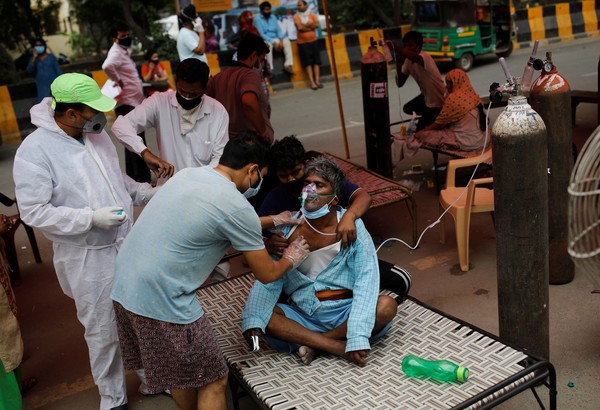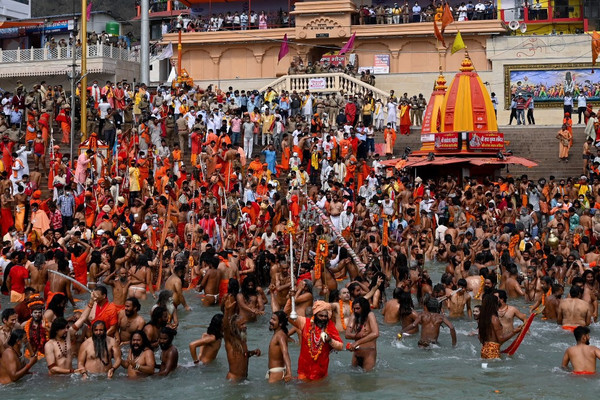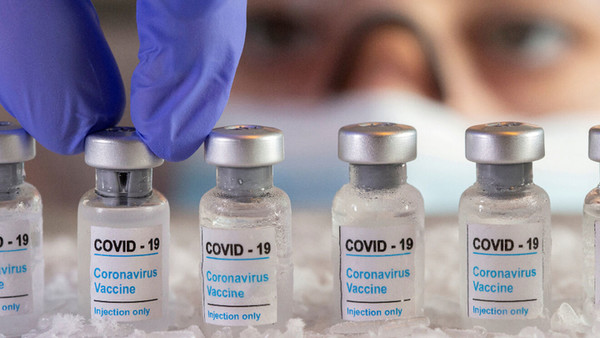
With the vaccine for COVID-19 virus being distributed to countries around the world, people expect the pandemic to be stabilized and allow them to return to normal life. In fact, in Israel, where the national vaccination rate exceeds 50%, the situation has been stabilized to the point where events are held without people wearing masks. However, amidst this seemingly hopeful situation, there is a country that made the world tense again: India. India had been on the decline of COVID-19 patients up till February this year, but the number of confirmed cases surged in March. India was in a major crisis, suffering from a shortage of medical facilities and vaccines, due to the ever-increasing number of new cases each day. Let us take a closer look at the serious COVID-19 situation in India.
1. The Situation in India
a. The Situation of COVID-19
India had 403,405 newly confirmed cases on May 8th, and this figure of more than 400,000 new cases per day is the highest ever recorded. By May 31st, India had a cumulative 28 million cases. However, experts said that the actual number of cases could far exceed this figure if the number of confirmed cases missing from official statistics are taken into account. According to an article by Reuters on May 1st, medical experts said the actual number of infections could be five to ten times higher than the official tally. Moreover, experts predicted that India's situation would worsen as hospitals in many areas were on the verge of collapse. Hard-hit areas such as Delhi and Maharashtra announced lockdowns. On May 29th, the Delhi government announced that the lockdown, which has been going on since April 19th, will be extended till June 7th. Maharashtra also announced on May 30th that the lockdown, which began April 5th, will be extended, until June 15th. As of May 11th, a total of 12,481 and 40,956 newly confirmed cases were reported in Delhi and Maharashtra respectively. Indian Prime Minister Narendra Modi said, in a speech to the nation on April 20th, that lockdowns were a "last resort" that should be avoided, but the Indian government was criticized for conducting large-scale religious festivals, which contributed to the spread of COVID-19. The Lancet medical journal criticized the Indian government on May 8th and blamed it for precipitating the second wave of COVID-19 in India.
b. Risk of Collapse of the Health Care System

India's biggest crisis was the shortage of oxygen. Due to the severe spread of the virus, many hospitals in India complained of a lack of oxygen. When infected with COVID-19, symptoms of shortness of breath occur, and oxygen equipment that provides high concentrations of oxygen is needed to treat the patients. However, due to the sudden rise in the number of COVID-19 patients, obtaining oxygen equipment became difficult. In New Delhi, India's capital, the lack of oxygen equipment killed at least eight patients, including one doctor, on May 1st during the 1 hour when new oxygen equipment was arriving at Batra Hospital, which treats COVID-19 patients. On April 23rd, 26 patients in critical condition died due to lack of oxygen at the Jaipur Golden Hospital in Delhi. Such a lack of oxygen equipment emerged as one of the most serious problems in India, where the number of confirmed cases is soaring. Families and friends of the patients also posted on their social media seeking oxygen.
In addition, the exhaustion of not only patients but also medical staff got worse as the number of confirmed cases increased rapidly. A young doctor, who was treating patients at a private hospital in Delhi, India, chose to commit suicide due to stress from excessive work, leaving his pregnant wife behind. Dr. Ravi Wankhedkar, former president of the Indian Medical Association, tweeted on May 1st, "This brings into focus the tremendous emotional strain while managing Covid crisis. This death of a young doctor is nothing short of murder by the 'system' which has created frustrations with shortage of basic healthcare facilities,” and criticized the medical system of India. In addition, according to data by the Indian government, the proportion of medical staff was insufficient compared to the total population, with one doctor responsible for 1,456 people from 2019 to 2020.
c. Lack of Places to Store Bodies
In addition to the lack of oxygen equipment, there was also the problem of the disposal of the bodies of the dead. Dr. Bhim Rao Ambedkar Memorial Hospital, a large national hospital in Raipur, Chattisgarh, India, where 12,239 people were confirmed on May 8th alone, had too many deaths to be able to store the bodies. The bodies here were loaded on hospital beds and left around the hospital. An article on April 12th in the Indian news, New Delhi Television Ltd, reported that there were too many bodies, so they were left beside garbage dumps outside the building or lined up on the hospital floor.
2. What Caused the Sudden Rise in Infection?
Some believe that the virus B.1.617, the mutant virus first discovered in India in October last year, and virus B117, the mutant form from the United Kingdom, may have spread the virus with a higher infection rate in India. According to an article in the National Geographic on April 29th, the Indian mutant virus B1.617 has caused more than 60% of all COVID-19 infections in the Indian state of Maharashtra alone. However, scientist Kei Sato, who led related research, said that the mutant virus might not be the direct reason of the sudden increases in COVID-19 cases. He commented that “It should also be noted that the number of viral sequences analyzed in India [about 100 sequence per day] is much smaller than the number of infected people in India [about 300,000 per day]. Therefore, we are still not sure the current huge surge of COVID-19 in India is due to B.1.617.“

A lower rate of people wearing masks may also have contributed to the spread of COVID-19 in India. According to Rajib Dasgupta, chairman of The Centre of Social Medicine and Community Health, the rate of mask wearing in India dropped by about 10% from 71% in August 2020 to 61% in late February. In addition, India spending in medical services stood at 1.28% of the GDP compared to 17% of the United States in 2018. This means that India's medical facilities were not properly equipped. Furthermore, the Kumbh Mela, a Hindu pilgrimage event held every 12 years, was held from January 14th to April 27th. On April 13th, 184,000 people were newly infected across India, and 110 new confirmed cases were found in more than 20,000 COVID-19 tests conducted by managers on event participants in Haridwar, where the event was held. Among the confirmed cases were 9 top religious leaders as well. It is also highly likely that the event resulted in more confirmed cases, as the managers predicted that nearly 900,000 people would have dipped in the holy river on April 14th, the day considered the most holy.
3. The Current Status Quo of Vaccination in India
Then what about the status of vaccination in India? Previously, only those who were 45 and older were eligible for vaccination, but from May 1st, all adults over 18 were also eligible for vaccination. However, experts predicted that they have little chance of being vaccinated. About 200 million of those aged 45 and older have not completed their second vaccination, and 615 million vaccines are needed to vaccinate all those aged 45 and older who have not yet received a single shot at all. In other words, there is not enough vaccine for the 600 million new people who are aged 18 or older who can now be vaccinated, since there is a shortage of vaccines that have to be supplied to people aged 45 or older. In fact, as of May 30th, only 12.1% of India's population received vaccinations, and only 3.2% of the total population are fully vaccinated.

Also, rising prices of vaccines made it harder to buy them. Previously, the Indian federal government was the sole buyer of the two approved vaccines, Covishield and Covaxin. However, the government of India made it possible for the governments of 28 states and private hospitals to negotiate directly with the market for the sale and purchase of vaccines. The open market naturally led to a rise in the price of vaccines. As of May 1st, the federal government still had 50% of the vaccine at one dose for 150 rupees, but states and hospitals had to compete for the remaining 50% of the vaccines at a more expensive price. Srinath Reddy, president of the Public Health Foundation in India, commented "All vaccination should be free, it's for public good. And why should states pay a higher price? They are also using taxpayer money,” and criticized the federal government.
4. The Responses of Other Countries
Indian Foreign Minister Harsh Vardhan Shringla recognized the oxygen shortage problem and was promised assistance from 40 countries to solve the problem. The United States announced on April 28th that it would provide India with thousands of oxygen tanks and concentrators worth $100 million. The United States has supplied India with 1,100 refillable oxygen containers on May 1st. In addition to these medical devices, the United States sent 20 million AstraZeneca vaccines to India in the first week of May, promising to provide more vaccines in the future. Canada also agreed to provide 5,000 remdesivir and 350 ventilators; and the remdesivir and 50 ventilators were sent to India from Canada on May 5th. Russia also promised to send 5 million Sputnik V vaccines to India and started to deliver them on May 14th. In addition, the British Association of Physicians of Indian Origin (BAPIO), which consists of doctors and medical staff from India, planned the BAPIO Telemedicine project, which strives to lessen the stress of medical staff in India by remotely doing rounds on patients in less severe conditions and in their home. The project received assistance and was cleared by the UK General Medical Council. The program has already started remote consulting at hospitals in Nagpur, Maharashtra, and plans to expand its projects in the future.
But at the same time as the country received support from other countries, the COVID-19 spread, which continues to increase, many countries locked themselves away from India. The Netherlands banned flights from India from April 16th to May 1st, and the United States announced on April 30th that it would restrict travel to India. Germany designated India as a "virus variant zone" and allows its citizens only to enter the country among those coming from India, and they must be quarantined for 2 weeks. Italy bans those who stayed in India 2 weeks before landing in Italy from entering the country. If their citizens return home, they were quarantined after being tested for COVID-19 when arriving in Italy from India. All of these measures are taken as despite COVID-19 tests and quarantine, there is still the danger of infection. For example, passengers on a flight from New Delhi to Hong Kong were all tested negative at departure, but upon arrival, 52 passengers tested positive. If it weren’t for the fact that Hong Kong quarantines all passengers from overseas for three weeks, this could have developed into a serious mass infection.
India's spread of COVID-19 is a reminder to us that no one is completely safe from the virus yet, despite many countries being vaccinated. Let's not forget that we should all be alert to COVID-19 by thoroughly adhering to quarantine rules and paying attention to personal hygiene. CAH sincerely hopes that India's spread of COVID-19 will become more stable in the near future so that there will be no further patients and deaths.

